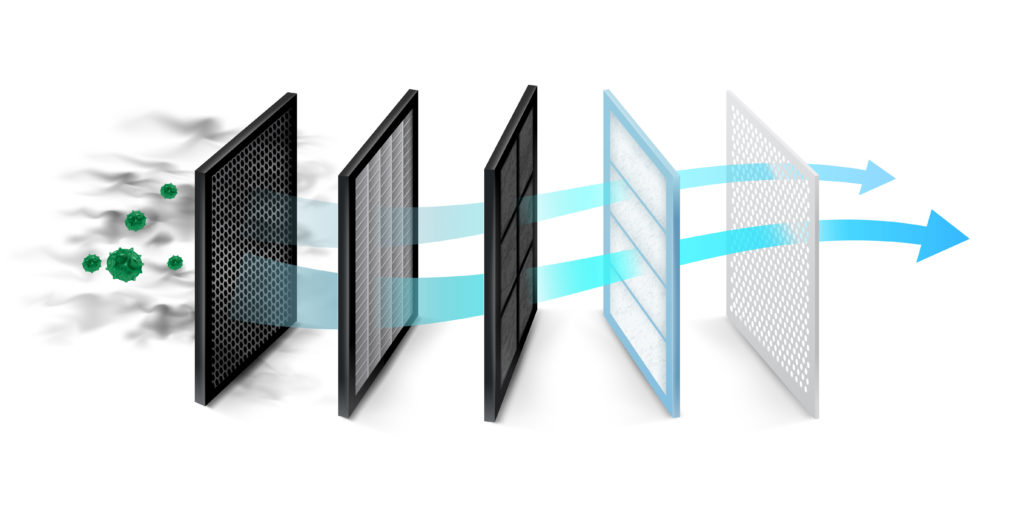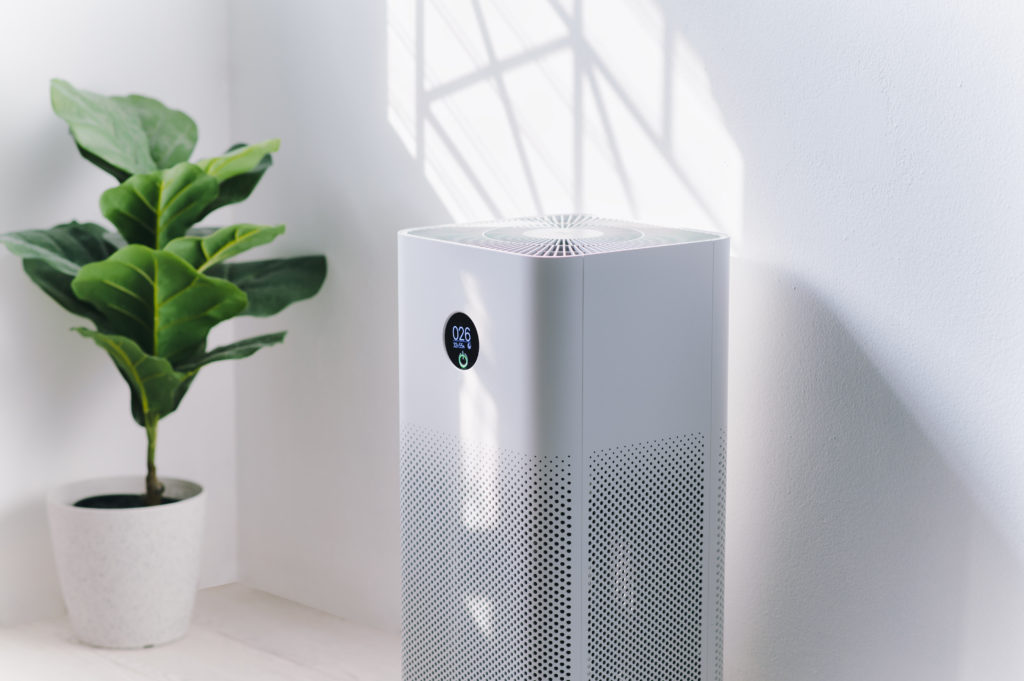Are you or a loved one sensitive to dust, pollen, and other particles in the air? Are you concerned about your lungs’ overall health? If so, you may want to invest in an air purifier. Air purifiers can greatly impact the air quality of your home and help mitigate the impacts of smoke, viruses, mold, and more.
There are many questions when it comes to air purifiers, but the most important might simply be: do air purifiers work? This post will answer all of your questions and more as you decide if an air purifier is right for you, and if so, what kind is best for your home.

Table of Contents
Air Purifiers: What You Should Know
So we know what air purifiers are. But how does an air purifier work? They have the potential to be similar in size and shape as a humidifier or oil diffuser, but instead of adding fragrance or humidity into the air, air purifiers suck in viruses, pollen, and more. And while they might seem similar to a filter, air purifiers can go an extra step by sanitising the air around you as well.
Who needs an air purifier?
- How do I know I need an air purifier?
- There are some signs that might indicate that you may need an air purifier to help address them. Allergy symptoms in the forms of a stuffy nose, itchy eyes, and headaches can be a sign that too much pollen or mold spores are in your living area. If you have asthma and you are seeing more flare-ups than normal, your home might not have great circulation and may need some help. If you walk around your living space and just see dust everywhere – on picture frames, on wooden tables, etc. – it might be from the air instead of not cleaning enough. Lastly, if your space is starting to smell because bad odors are lingering, it might be time to get an air purifier to help circulate the air.
- What are the disadvantages of an air purifier?
- While air purifiers are easy to start and let it work, it can be a chore to remember to change out the filter. And if it is not switched out, the filter itself could become a hotspot for mold and bacteria growth. While air purifiers do help clear the air, there is not one that cleans the air 100%. Some air purifiers may work better on bacteria than smoke and vice versa. It all depends on your needs and wants. Surprisingly, air purifiers may also add ozone emissions into the air as a byproduct. Also, if the pollen, dust mites, and other particles are not in the air but on the ground, rugs, or even furniture, the chances of them being caught by a purifier are very slim.
- Are air purifiers worth it?
- While air purifiers are not 100% effective, they still can make an impact on your home and your life.
What particles can an air purifier address?
- What kind of particles can air purifiers remove?
- There are plenty of particles air purifiers can take out of the air. Some of the most popular ones include allergens like pollen, dander from your pets, and those ever-seemingly invisible dust mites. Air purifiers also have the ability to take some amount of mold out of the air. Other particles include some smoke (if your air purifier contains a filter) and even some toxins like those from cleaning products.
- Can air purifiers help with pet hair?
- If you are a pet lover, you know how much pets can possibly shed. If you want to keep the pet dander down as you know people who visit may be allergic or just want less hair in the air, you may want to consider adding an air purifier to your routine. While constant cleaning won’t fully rid of pet hair and dander, an air purifier can help clear the air of both. Just make sure you clean out your filter regularly to keep it working properly as pet hair can be varied in sizing.
What kind of air purifier is best for my home?
- What kind of air purifiers are there?
- There are actually a number of air purifiers to choose from. From size and shape to air filter type, you can choose what works best for you.
- If you want something small that packs a punch against pathogens, then you might want to consider an ultraviolet air purifier.
- If trying to get rid of pollen, dander, and mold are more your focus, then look into some HEPA air purifiers.
- Activated carbon air purifiers help to focus on smoke, fumes, and gasses which is helpful for shops and garages.
- Ionic air purifiers are really making a technological impact on the air purifier world as it not only focuses on anything in the air short of odors, but some can even clean themselves.
- If you want to focus on the entire home and not just a specific space or room, you may want to look into electronic air cleaners that work with your furnace.
- Similarly, central air cleaners team up with your central heating and cooling systems to help with dust, pollen, and viruses.
- Lastly, air-to-air exchangers are best for homes that have little air circulation as they bring in air from outdoors to indoors.
- Beyond all of these examples, there are also air purifiers that are made for traveling and for your personal space in the form of a necklace.
- There are actually a number of air purifiers to choose from. From size and shape to air filter type, you can choose what works best for you.
- Can air purifiers travel on the go?
- They can be portable if they are small enough. But there are also plenty of to-go air purifiers as well. There are even air purifiers for your car and to wear around your neck for your personal space. So if you plan on taking a trip and want to keep one either in your bag or on your person, there are definitely smaller options for that.
- Are air purifiers boring in design?
- No, they don’t have to be. Some are sleek and minimalist in order to not command attention within your home or space.
Where should an air purifier be placed?
- Where can you place an air purifier?
- When you are trying to decide where you would like to place your air purifier, there’s a few factors to consider. Think about which part of your home has the most pollutants like smoke or mold and even where might have the highest air exchange. This can be like a hallway or near a window or doorway. It is best to place your air filter about 3 to 5 feet off the ground so it can be a part of your home’s vertical air flow in that space. In order to get your air purifier working at its max, it’s best to not place it in a corner or by potential obstacles. This can limit air flow to and away from it. Also, do not put it in spaces that are very humid like the bathroom or kitchen as it can wear down your filters and for safe practice, do not place it near an electronic device. However, feel free to move it around when you want or need so that way all areas of your home can be cleaned by the air purifier.
- Where should you place an air purifier in your home?
- It is best to keep it away from other items that might result in it falling over or not being able to circulate the room’s air.
How long should it take for me to see a change in my air quality?
- How long does it take for an air purifier to clean the air?
- Depending on the air purifier you purchase, it could clean the air in a room within 45 minutes to three hours. Of course this also depends on the size of your room, how many particles are in the air, and if you change out a filter (if you have one). However, you can feel a change in the air even sooner than that.
- How do you know if your air purifier is working?
- As you likely cannot see if particles are disappearing in the air, there are a few other ways to make sure your air purifier is working properly. First, make sure that the fan is pushing the air flow. However it might need to be replaced if the fan is spinning too hard or not at all. Another way to check is by looking at the filter to see if it’s clean or dirty. If it is dirty, be sure to change it out for a new one for properly cleaned air. Lastly, if you want to be more careful about if your air purifier is doing its job, use an air quality monitor for a numeric scale. If there is an improvement between when your room is not being cleaned by the purifier and when it is, then you can safely say that it is working.
Air purifiers can greatly make an impact on your home. From choosing the right one to knowing which pollutant you want to combat in the air, there is plenty of thinking to do. Of course, fortunately, there are plenty of options to choose from as well. Choose what is best for you and your home – and even those best for your on-the-go life as well! We hope this information will assist in your decision making process as you strive to make your home cleaner and fresh.



